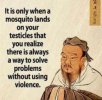There are loads and loads of examples of tests demonstrating that even ‘the ancient masters’ didn’t have the control needed to nail this. What was once the pinnacle of advancement and technology is today’s ’also-ran’.
Nate’s pretty big on pointing this out - does anyone truly believe that Musashi would elect to use nihonto from 700 years ago today, if he had access to a sword made by CPK or Dan Keffeler? I think it’s more than fair to present the parallel of using a chariot for battle versus an F35. We haven’t sat still in our development.
…and bluemax_1, I know you know all this, I’m just quoting you because it was the obvious segue.

A post very much worth quoting.
There's a world of a difference between "good enough" a few centuries ago, vs literally cutting edge heat treats that Nate's done all his research on.
For folks who may have missed a couple of the posts I made on swords, here's a basic summary;
Researchers and folks studying historical weapons have done actual testing on museum pieces, to document various aspects. One of those, was the hardness, and heat treat consistency. What all the testing showed, was that the consistency of historical pieces simply isn't very good.
Not only did the edge hardnesses range widely, sometimes as low as in the 40s hRc, to the lower to kid 50s hRc more common in Western swords, they also tested the variance in individual swords, measuring the edge hardness every 5cm down the edges, and found variability pretty common there as well (eg. Swords would show softer edge sections, and harder edge sections along the edge).
And as for historical Nihonto/katana/tachi; While most enthusiasts/fans have heard of the differential hardness, with a softer spine for shock abso6,and a harder edge for edge retention and cutting, most historical Nihonto have edge hardnesses in the mid to high 50s hRc. 60 hRc is not very common from all the Japanese swords tested.
CPK's K18 and K20 are 60.5 hRc. They're already harder than historical (and modern reproduction) shinken, but what REALLY blew my mind, was the video of the K18 flex test (and later, the same test with a K20), bending them that far, and the sword returning to true. Nihonto would fail that test. The Western style swords that can pass flex tests that extreme, are generally in the low 50s hRc. Until the K18 video, I had no idea that D3V could do that.
Another datapoint is the hullabaloo back when Howard Clark first developed his L6 Bainite katanas. They were dubbed the "indestructible katana', and there used to be video of one of them bashing through cinder blocks (another test that traditionally made Nihonto/shinken would fail at), but as more of them made it into the hands of actual practitioners of Japanese sword arts, one of the comments that began popping up, was that while the toughness was off the charts vs normal katana, the edge holding when used for tameshigiri, was subpar.
That's where CPK's D3V blows away all contenders. Edge holding WITH incredible toughness AND consistency. Can't remember which bladesmith stated something like, "These are the best swords being made, in the world", but it wasn't hyperbole.
*** And the pair of K20 I received from the preorder weigh within a fraction of an ounce to each other.



